TWTR closed Friday trading at $64.50, up 1.6% with IV30™ falling about one point. The LIVEVOL® Pro Summary is below.
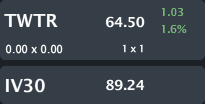
Provided by Livevol
Twitter, Inc. (Twitter) is a global platform for public self-expression and conversation in real time. Twitter is a real-time platform, where any user can create a Tweet and any user can follow other users.
This is a volatility note regarding earnings for TWTR and two quite surprising phenomena.
I wrote about TWTR in prior posts and how I saw what appeared a total mis-pricing of risk in the options (although that was unrelated to an earnings event). You can read that interesting tale by clicking on the title below:
Twitter (TWTR) - UPDATE: How the Option Market Totally Blew It, And We Knew it Two-Weeks Ago.
But let's focus on earnings volatility and the earnings event, which is due on 2-5-2014 AMC (aka Wednesday).
Let's start with the Charts Tab (below). The top portion is the stock price, the bottom is the vol (IV30™ - red vs HV20™ - blue vs HV180™ - pink).
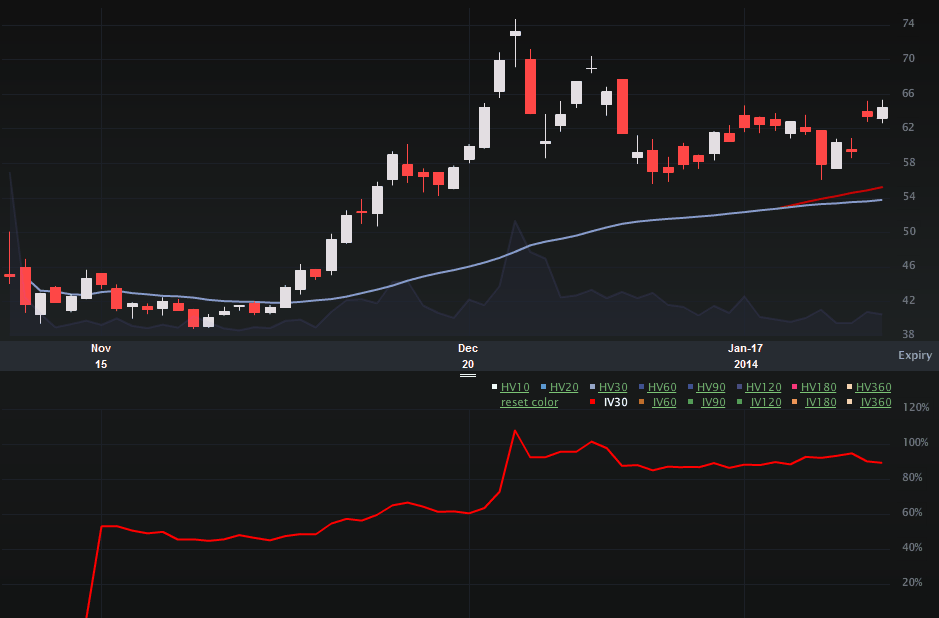
Provided by Livevol
Obviously there isn't a lot of history for TWTR, but even in this short-time period we have seen the stock trade as low as $38.80 and as high as $74.73. I'd say the equity market hasn't quite reached equilibrium on this name yet and its first earnings report is going to be the beginning (not the end) of reaching that equilibrium.
But ultimately, I want to examine the implied volatility, so let's turn to the IV30™ chart in isolation, below.
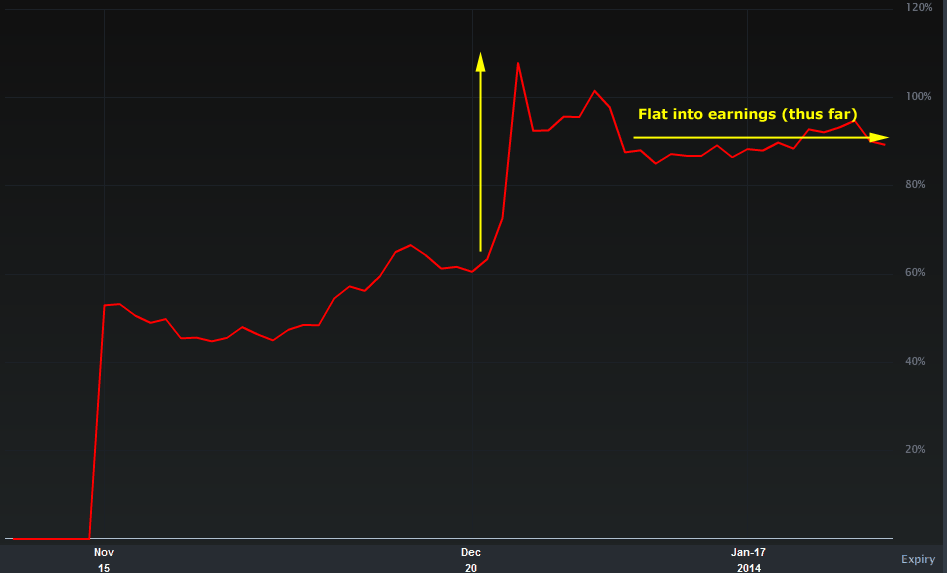
Provided by Livevol
Interestingly, the implied volatility has not been rising into earnings, but has actually been flat. The rise in the implied occurred just after my original post which questioned, in simple terms, "what the heck is TWTR vol doing trading so low?"
So, phenomenon number one that I want to point is simply that the vol in TWTR has not been reacting to this upcoming event (it's been flat). But there's a caveat here, and it's a big one, I'm writing this article on Sunday afternoon. It would not surprise me if the vol starts climbing rather abruptly in to Wednesday's close (the earnings date). I would in fact be surprised if TWTR implied does not go back to over 100% before the earnings release.
The second phenomenon I want to point out can be seen in the skew. The Skew Tab is included below.
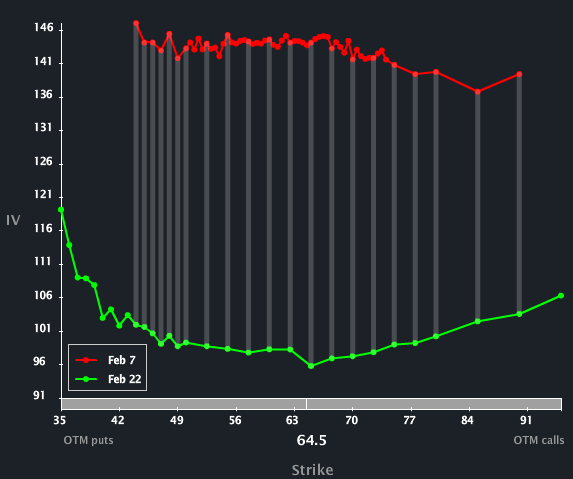
Provided by Livevol
I have included the Feb 7 (weekly) and the Feb monthly options. Obviously the Feb 7 weeklies are elevated to the Feb monthly vols b/c of earnings -- by the end of trading on Wednesday, those Feb 7 options will represent essentially pure earnings vol and will be even more elevated. So, the fact that the weeklies are elevated to the monthlies is normal and expected.
My curiosity surrounds the size of that elevation.
To read more about option skew and why it exists, you can read the post below:
Understanding Option Skew -- What it is and Why it Exists
Finally, let's look to the Options Tab (below) to put some numbers to that volatility difference.
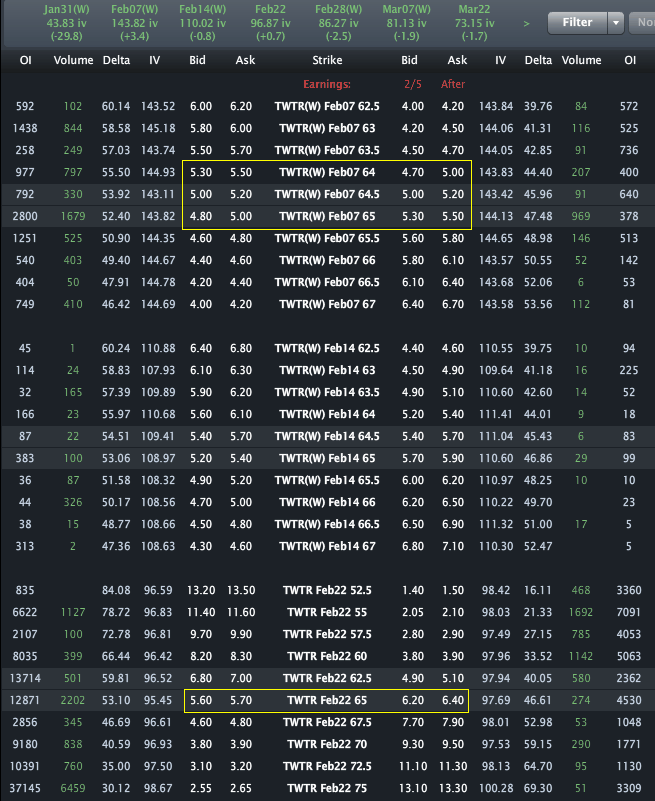
Provided by Livevol
The Feb 7 weekly $65 strike straddle is priced to ~$10.30. The Feb monthly $65 strike straddle is priced to ~$11.90.
So, basically, that means the time between Feb 7 and Feb 21 (Feb monthly expiration) is worth ~$1.60 on $65 strike straddle. This implies (sort of) that whatever the move is off of earnings, the stick movement after Feb 7 but before Feb 21 is going to be pretty muted.
Why do I say "sort of"? Keep in mind that if the stock moves wildly away from $65 off of earnings, the vega (volatility dollars) in the Feb monthly $65 straddle will tend to zero as those options become deep in the money (far out of the money). If that happens, $1.60 will seem pretty expensive for just the volatility. But if doesn't... well, then it won't...
Seriously, this is trade analysis, not a recommendation.
In any case, let's revisit TWTR and this article on Wednesday pre-earnings. A lot can change in the next three trading days.
Follow @OphirGottlieb
Tweet
Legal Stuff:
Options involve risk. Prior to buying or selling an option, an investor must receive a copy of Characteristics and Risks of Standardized Options. Investors need a broker to trade options, and must meet suitability requirements.
The information contained on this site is provided for general informational purposes, as a convenience to the readers. The materials are not a substitute for obtaining professional advice from a qualified person, firm or corporation. Consult the appropriate professional advisor for more complete and current information. I am not engaged in rendering any legal or professional services by placing these general informational materials on this website.
I specifically disclaim any liability, whether based in contract, tort, strict liability or otherwise, for any direct, indirect, incidental, consequential, or special damages arising out of or in any way connected with access to or use of the site, even if I have been advised of the possibility of such damages, including liability in connection with mistakes or omissions in, or delays in transmission of, information to or from the user, interruptions in telecommunications connections to the site or viruses.
I make no representations or warranties about the accuracy or completeness of the information contained on this website. Any links provided to other server sites are offered as a matter of convenience and in no way are meant to imply that I endorse, sponsor, promote or am affiliated with the owners of or participants in those sites, or endorse any information contained on those sites, unless expressly stated.



No comments:
Post a Comment